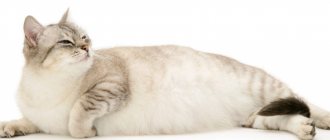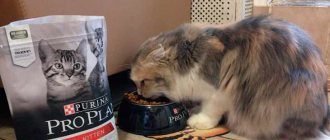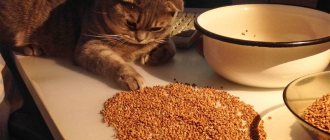About the benefits of chicken meat
It's no secret that chicken meat is considered dietary. It is easily absorbed by the body, so even people weakened after surgery are recommended to first eat nutritious chicken broth, then add white chicken breast meat to the diet.
The big advantage is that chicken meat is inexpensive and cooks quickly. The product contains a large amount of easily digestible protein, and the tender consistency of the meat is liked not only by people, but also by pets. It is provided by a minimal amount of connective tissue. The digestibility of chicken meat is 90%.
Chicken has two types of meat: white and red. Chicken breast meat is commonly called white. It contains less fat and more protein, and is considered dietary because it is low in calories (about 110 kcal per 100 g of product). But veterinarians do not recommend feeding your cat only white meat. Yes, it contains more magnesium, but red contains no less important microelements - iron and zinc, as well as vitamins.
Chicken meat contains vitamins necessary for any living organism, including A, group B (B1, B2, B4, B5, B6, B9 and B12), C, D, E, K, PP. In addition, chicken contains:
- calcium;
- magnesium;
- phosphorus;
- potassium;
- sodium;
- iron and other trace elements.
The rich composition of nutrients allows veterinarians to recommend feeding domestic cats chicken meat - not only the breast, but also other parts of the carcass. However, it is strictly forbidden to give skins and long bones to your cat. Leather is poorly digested in the stomach of pets; moreover, it contains a lot of fat and, if eaten regularly, even in the healthiest cats, will eventually cause problems with the liver, pancreas, and gall bladder. When chewed, tubular bones break into sharp fragments. They can injure the intestines, so they are prohibited for cats.
Can I give it to a cat?
Prohibited types of chicken
Fried poultry negatively affects your pet's digestive system.
Veterinarians prohibit giving poultry fried, as such a dish contains too much fat. Consumption will cause diarrhea and vomiting in the pet. Frequent inclusion of fried foods in the diet is also fraught with obesity, pancreatic failure and chronic disorders of the gastrointestinal tract. It is better to remove the skin, even if the bird is served boiled.
Pepper, salt and adding other spices are prohibited in chicken meat. It is especially important to exclude condiments for a neutered cat, because he is at increased risk of developing urolithiasis. Veterinarians do not recommend feeding your cat raw chicken, since only heat treatment can destroy parasites and worms. You should also avoid giving your pet bones, head and paws. Accidentally swallowing a piece of tubular bone can be fatal, especially if it is caught by a kitten. If the owner decides to include the head or paws of a chicken in the diet, then veterinarians focus on the mandatory removal of claws and beak.
Which chicken is good for cats?
The raw product takes longer to digest, but saturates the pet better.
Of all the parts of the bird, it is preferable to give the animal the breast.
When creating a menu, veterinarians recommend adhering to the following recommendations:
- The most useful part is breast fillet, since it does not contain a minimum of fat and does not have tubular bones.
- You can give raw poultry to an adult cat provided that it has been in the freezer for 3-4 days. Low temperatures kill parasites just as well as high temperatures.
- For a kitten, it is better to puree the boiled breast until it becomes pureed.
- The liquid formed after defrosting must be removed.
- The best way to prepare the dish is boiling, because most of the vitamins and microelements remain in the chicken.
- By-products should make up at least 30% of your pet's diet. The most useful are the liver and kidneys.
- Chicken hearts and stomachs are rich in vitamins and nutrients, but this meat is tough due to the high muscle fiber content, so it needs to be finely chopped before serving.
- Raw liver can cause diarrhea, and boiled liver can cause constipation. Therefore, a useful product must be given in doses.
Should I give raw or boiled meat?
Cats are carnivores, and in the wild no one cooks food for them, so the digestive system of pets can handle raw meat quite well. Therefore, such food is physiologically closer to cats. Another thing is the individual preferences of animals, which depend on what food the animal has been accustomed to since childhood.
Chicken meat is extremely rarely infected with helminths, so in this regard, a cat eating raw chicken is not in danger. Fish and other types of meat pose a great danger - for example, pork, which veterinarians generally do not recommend giving to cats.
Much more dangerous is the possible infection of a pet with salmonellosis. The causative agents of the disease are Salmonella - bacteria that remain active for a long time and are practically insensitive to low temperatures. But at +75 degrees, pathogenic microorganisms die. A 10-minute heat treatment will be enough to kill germs. A side effect of this treatment is that some of the nutrients are lost. The conclusion suggests itself: cats can have raw chicken meat, but only if it is purchased from a trusted seller and has been tested for salmonella.
Why is salmonellosis dangerous?
Salmonellosis is dangerous not only for cats, but also for humans. And more than a third of domestic animals with strong immunity that have eaten meat contaminated with salmonella will forever remain carriers of the pathology. The weakened body of a cat (small kittens, elderly animals) may not be able to cope with the infection.
The disease is always severe and accompanied by severe symptoms. You can observe in your pet:
- refusal of food;
- attacks of high fever;
- increased body temperature;
- apathy;
- diarrhea, feces have a dark, almost black color and a foul odor, and may contain streaks of blood;
- frequent vomiting with foam;
- cough;
- labored breathing.
The cat may experience severe pain in the abdomen, does not allow it to be touched, and shows aggression. With salmonellosis, the permeability of the vascular walls increases, which accelerates the penetration of pathogenic microorganisms into the body. Without prompt veterinary care, kittens, animals with low immunity and elderly animals die within 1-2 days from dehydration or sepsis.
How to feed and how long to cook chicken for a cat
How long should you cook chicken so that it is healthy for your cat? This must be done until it becomes soft. If the pieces are small, then 10-15 minutes of cooking will be enough. It is not advisable to give pieces from soup or side dishes because they contain salt and seasonings that cats do not need.
To be able to safely give boiled meat to cats, is it worth adhering to some rules for using chicken? Necessarily:
- buy meat in reliable stores, where it undergoes strict veterinary control;
- choose only fresh product, without unnecessary odors;
- Before feeding, remove all bones, tendons and skin from the meat that could cause the animal to choke;
- combine white and red meat. The breast is too dry to feed a cat. And the pulp of the thighs contains a higher content of fats, which have better nutritional properties;
- In order to feed your kitten boiled chicken, you need to make sure of its quality: does it contain additives? Before serving, cut the meat into the smallest pieces;
- add to meat and offal. But don’t get carried away (especially with the liver);
- If an animal develops an allergy or feels unwell, contact a veterinarian immediately.
Cats naturally eat raw meat. Therefore, many owners prefer to feed their pets uncooked chicken. However, this is very dangerous; there is a high probability of infecting the cat with salmonellosis. Almost a third of birds are carriers of this bacterium.
Signs of a cat being infected with salmonellosis are loose stools, vomiting, and lack of appetite. Therefore, if you want to feed your cat fresh meat, first cut it into pieces and freeze it. This way the bacteria will be destroyed and the pet will remain healthy. By-products left over from chicken should also be added to the cat's food. However, it is better that they also undergo heat treatment.
Is it possible to give heads and paws
Chicken can be the basis of your pet's diet, but you should not feed it chicken breast alone. Already from 3.5-4 months of age, kittens can be given chicken legs, and by about a year - and heads by removing the beak.
Benefits of chicken heads:
- scallops and eyes contain collagen, a component of protein;
- the brain is a source of fat and B vitamins;
- The soft bones of the head ensure the supply of calcium to the cat’s body.
Cats need bones because they are a good source of calcium and phosphorus. By chewing chicken heads, the cat trains its chewing muscles and strengthens its gums.
Important!
It is not recommended to give boiled bones to cats - they clog the animal's digestive tract.
It is recommended to give chicken heads to kittens - during the growth period they need to ensure that their body receives a sufficient amount of protein, fats, and beneficial microelements. Pregnant and lactating cats will benefit from calcium and phosphorus, contained in sufficient quantities in chicken heads.
However, they should be given to pets carefully - no more than one head per meal. Overeating can lead to problems with the digestive system. In addition to heads, you can give cats chicken by-products: liver, kidneys, lungs, hearts.
Important!
Cats usually love liver, but it is best to give it no more than once a week. More frequent consumption of liver negatively affects the appearance of the animal and the quality of the coat.
Kittens and adult cats, as a rule, are reluctant to eat other offal products. Therefore, they are rarely included in the diet of pets. If the cat does not refuse such food, you can give him chicken hearts instead of meat once a week.
Standard cat diet
Everyone knows that cats are carnivorous animals, that is, it is normal for them to eat meat. In nature, animals do not prepare their own food, they eat what they managed to catch along with wool, bones and entrails. If we are guided by this argument, then all the rules for keeping pets will lose their relevance.
The truth is that our domestic cats have long moved away from wild ways of life, although they have retained excellent hunting skills. As before, tailed animals need meat, but in addition to it, cats can receive a number of varied, tasty foods, vitamin supplements, treats and industrial food.
Industrial diet
Let's briefly look at industrial feeds. The option preferred by many is “drying”. There is no doubt about it, dry food is convenient, easy to store, dose, and most importantly, there is no need to prepare it. In addition to drying, manufacturers offer semi-moist food and canned food that can diversify your pet’s diet.
When choosing food, it is important to understand that products are divided into classes:
• Economy is the cheapest food, not recommended for daily use.
• Premium and super-premium – the middle price segment for everyday feeding.
• Holistic – special or medicinal foods used for urolithiasis (urolithiasis), food allergies and other ailments.
The choice of brand, line and type of product is an individual matter. Naturally, it is better to focus on manufacturers with a good reputation and products of original quality. What you should not do is mix industrial food with natural food. If you decide to feed your cat chicken and dry food, you will not see particularly serious consequences, at least not immediately. However, be aware that you are putting your cat's body at a crossroads. Her digestive system can digest either food or chicken, but cannot digest two foods at the same time. It turns out that the pet will not be able to absorb all the beneficial substances from the food, but will simply fill its stomach.
Natural diet
Chicken meat is combined only with a natural diet. Obviously, chicken meat alone will not be enough for a cat. Chicken can and should be alternated with beef, veal, rabbit, quail and turkey. Equally important are by-products that complement and do not replace meat. What other products should be included in the menu?
The protein a cat gets from chicken is not enough, so other sources of protein should be included in the diet:
- Milk is suitable for kittens and adult animals that do not have lactose intolerance.
- Dairy products (ryazhenka, yogurt, natural yogurt, low-fat sour cream, kefir) can be given every day, controlling the fat content of the products. Homemade products are healthier, but fattier, that is, they need to be introduced into the cat’s diet gradually.
- Eggs – boiled and raw, chicken and quail. Possible 1-2 times a week. Some cats have allergies, in which case the product is excluded from the diet. Raw eggs can be given to your pet if you are confident in their quality and freshness.
- Fish and seafood are rich sources of proteins and microelements and at the same time very controversial products. Sea delicacies can serve as a source of helminth eggs. Inhabitants of the seas often carry not eggs, but worm larvae ready to molt. River varieties of fish are especially dangerous. Nutritious and healthy fish are dangerous because of their bones, which scratch and even pierce the mucous membranes. Be careful to feed your cat only ocean, boiled, and deboned foods.
- Vegetables and greens are an integral part of a cat's natural diet. In addition to vitamins, these products contain fiber. Without plant food, a cat's digestive and metabolic processes are disrupted, that is, even meat will not be fully digested.
Tip: To prevent your cat from developing a fiber deficiency, plant special grass for it.
Raw eggs
Breeders are also concerned about the question of whether cats can have raw eggs. It seems that giving cats eggs is not worth it at all, but from the point of view of complete proper nutrition for your mustachioed friend, chicken eggs are very useful. They contain animal protein, which is very easily digestible, and in addition - a whole list of vitamins and microelements that a cat needs. Thus, it can be argued that eggs are a necessity.
But in what form should you give them to your cat, and is it worth feeding cats raw bird eggs? Here it is worth paying attention to the dangerous possibility of the presence of the causative agent of salmonellosis in raw eggs. And if previously it was believed that quail eggs were immune from this, today salmonella is increasingly found in quails. Therefore, in order to avoid problems with the pet’s health, it is recommended to boil eggs before feeding.
In this way you will protect your cat from illness and allow him to receive a lot of useful elements and nutrients. So we have figured out the answer to the question of whether it is possible to give raw eggs to cats.











